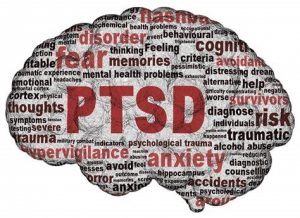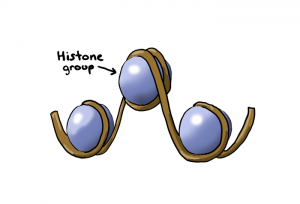
Everyone experiences stress in their life, whether that being from school, work, or daily life. Imagine never getting to escape those stresses. That’s exactly what individuals who suffer from anxiety and PTSD experience on a daily basis. Strong psychologically stressful events are known to have a long-lasting effect on the behavior of an individual. The consolidation of these stressful events can lead to changes in gene expression and hippocampal function causing stress-related mental disorders such as major depressive disorder, anxiety disorder, and PTSD. Though the understanding of this process is still largely unknown, scientists are making advances in their research quite rapidly giving us a much better idea of the causes behind these illnesses.
What is Anxiety:
Anxiety disorders are a group of mental illness that includes panic disorder, social anxiety disorder, specific phobias, and generalized anxiety disorder. Symptoms include panic, fear, sleeping problems, inability to stay calm or still, shortness of breath, dizziness, tense muscles, and a variety of other symptoms.
What is PTSD:
PTSD is a disorder that develops in some individuals who have experienced a shocking, scary, traumatic or dangerous event. Of course, everyone experiences fear and shock in a traumatic event due to the “fight or flight” response, yet those who never recover from the initial symptoms may be diagnosed with PTSD. These individuals can feel frightened or in danger in normal, everyday situations. To be diagnosed with PTSD, symptoms must last more than a month and be severe enough to interfere with relationships or work to be considered PTSD. The patient must also have at least one re-experiencing symptom, at least one avoidance symptom, at least two arousal and reactivity symptoms, and at least two cognition and mood symptoms.
Memory:
Making memories is vital to our life functioning, obviously. But is there such thing as too much memory? Memories allow us to interact spatially, socially, and with our environment. They are crucial in our ability to adapt as they prepare us cognitively, emotionally, and physiologically for similar situations we may see in the future. However, the memories we make during more traumatic events in our life are much stronger as they have a larger impact on us as individuals. When these memories become too strong in certain individuals, they can develop symptoms associated with anxiety and PTSD. Why these memories become so strong are unknown, but certain social factors can predispose individuals toward the development of PTSD as their adaptation and coping mechanisms can fail. It is estimated that 10-20% of the population will develop a stress-related disorder after experiencing a traumatic event, but why is still largely unknown.
When they body is exposed to a traumatic event, it releases glucocorticoids which bind to receptors. This binding triggers a cascade of events which then activates a protein called EKR. EKR then works to activate ELK-1 and eventually a molecule that modifies histones.

Histones wrap DNA around themselves for consolidation within the cell, controlling which segments of DNA are exposed to be transcribed. When these histones are modified, areas that are not normally able to be expressed can become exposed.
Treatment:
Medication:
Medications used to treat PTSD are almost always used in conjunction with psychotherapy as they can treat symptoms commonly associated with the disorder but cannot relieve a person in terms of flashbacks or feelings associated with the original trauma. These medications only treat symptoms as they mechanism for this strong memory consolidation is sill largely unknown
• The most commonly prescribed class of medication for PTSD (and approved by the FDA) are the serotonin reuptake inhibitor (SSRI) antidepressants. These include drugs such as fluoxetine (Prozac), sertraline (Zoloft), and paroxetine (Paxil). This group of medication tend to decrease anxiety, depression, and panic associated with PTSD. These may also help reduce aggression, impulsivity, and suicidal thoughts. These medications usually take 6-8 weeks to work, and many people need to try several types of these antidepressant before they find one that works for them. Relapse of PTSD is less likely when on the medication for longer than one year. These types of medications are especially useful in individuals who have issues with substance abuse or suffer from depression.
• The most common alternative to antidepressants for PTSD are atypical antipsychotics. Atypical antipsychotics include medications such as risperidone (Risperdal), olanzapine (Zyprexa), and quetiapine (Seroquel). Antipsychotic medicines seem to be most useful in the treatment of PTSD in those who suffer from agitation, dissociation, hypervigilance, intense suspiciousness (paranoia), or brief breaks in being in touch with reality (brief psychotic reactions).
• Other medications include mood stabilizers and benzodiazepines ( commonly referred to as minor tranquilizers, sleeping tablets, or anti-anxiety medications)
Psychotherapy:
Trauma-focused psychotherapy, otherwise known as “talk therapy”, is the most effective type of talk therapy for PTSD. There are three most common types of treatments and these have the most research support. In each of these therapies, the patient usually talks with the therapies once a week for 60-90 minutes and last 3-6 months. The therapist teaches the patient specific skills to manage their PTSD symptoms.
• Cognitive Processing Therapy (CPT) Teaches you to reframe negative thoughts about the trauma. It involves talking with your provider about your negative thoughts and doing short writing assignments.
• Prolonged Exposure (PE) Teaches you how to gain control by facing your negative feelings. It involves talking about your trauma with a provider and doing some of the things you have avoided since the trauma.
• Eye-Movement Desensitization and Reprocessing (EMDR) Helps you process and make sense of your trauma. It involves calling the trauma to mind while paying attention to a back-and-forth movement or sound (like a finger waving side to side, a light, or a tone).
Bibliography:
https://psychcentral.com/disorders/ptsd/posttraumatic-stress-disorder-ptsd-treatment/
https://www.ptsd.va.gov/understand_tx/tx_basics.asp
https://www.nimh.nih.gov/health/topics/post-traumatic-stress-disorder-ptsd/index.shtml
https://www.webmd.com/anxiety-panic/guide/anxiety-disorders#1